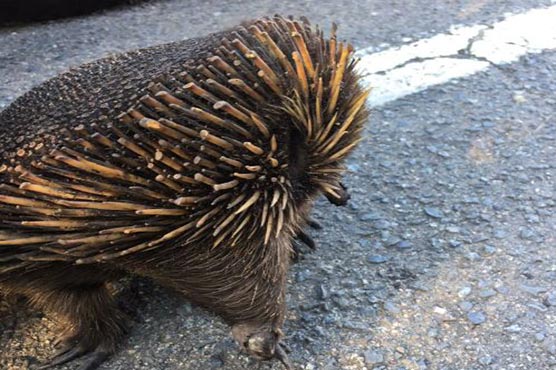Zoologists find weird Echidna that possesses impressive bushfire strategy

"We've seen the spines actually melted down to little nubs on the body."
(Web Desk) – Echidnas are one of Australia’s cutest and weirdest animals. The spiky creatures lay eggs even though they’re mammals, they eat termites but they’re not related to anteaters, and they evolved from an ancestor shared with the duck-billed platypus.
And now we’ve learned they also have one of the most impressive bushfire strategies we’ve ever heard – they just go to sleep, even if they end up a little less spiky afterwards.
Despite how unique echidnas are, we don’t know that much about them in the wild, and the group Echidna CSI is on a mission to get as many photos and samples of their poo as possible.
That was how Echidna CSI ended up with a picture of a particularly flat echidna, taken by member Georgina Swan – you can see the image below, and it’s quite a sight.
This #echidna caught our eye straight away, what an odd sight – what could have happened to its spines? But apparently the bushland around where it was seen had recently been controlled burned! #EchidnaCSI #science (1/5) pic.twitter.com/GrIDYLjoDY
- EchidnaCSI (@echidna_csi) August 18, 2019
So, what happened here? Well the team at EchidnaCSI point out that there was a bushfire nearby, so this little guy was probably caught in it. But how did it escape with just its spines scorched?
"We’ve seen a lot of echidnas that have been through fires and have lost either a lot or only a few spines," environmental physiologist Peggy Rismiller from the Pelican Lagoon Research Centre told ScienceAlert.
"We’ve seen the spines actually melted down to little nubs on the body."
This might sound particularly painful, but Rismiller says not to worry too much, as it wouldn’t hurt quite as badly as you might imagine.
"The spines are modified hairs," she explained. "So, you know, they do grow back."
Rismiller has spent 30 years studying echidnas, one of the oldest surviving mammals in the world.
"When I started my research in 1988, there were still about seven basic questions that were unknown about echidnas that had been asked in the 1830s," she explained.
"Basics such as ‘when is an echidna sexually mature?’, and ‘when they are sexually mature, how often does it actually reproduce?’. We’ve done a lot of work in 30 years, actually filling in much of their biological mysteries."
For example, we now know echidnas don’t try to escape a fire, instead they bury themselves as deep as they can into a cool, protective soil, take a nap, and wait for the flames to all blow over.
Although this is no ordinary nap. It’s similar to hibernation, but a shorter and shallower state called torpor. It allows echidnas to lower their body temperature and their metabolic rate, so that they can conserve energy while out-waiting danger.
"They slow down their heart rate and their breathing and their metabolism, down to about three breaths a minute," Rismiller explains.
But before napping, our flat echidna might not have buried itself quite low enough to entirely avoid the fire, hence the damaged spikes.
"We’ve seen echidnas that couldn’t completely bury themselves and get soil between the spines because there were rocks or roots. These exposed spines melted down to little nubs," she said.
"There have been instances when fire trucks go through after a fire that half buried echidnas had some of their spines basically cut off."
Although most echidnas are happy to walk away after a situation like this, we’re still don’t know what it’s doing to them longterm.
"We’re not quite sure how badly fire affects them," Rismiller adds.
"Monotremes - echidnas and platypus - are the longest surviving mammals, so they have actually evolved in Australia with natural fires. It is part of their environment and part of their evolution as well."
We’re just glad to know that our flat echidna will be okay. What amazing animals!

